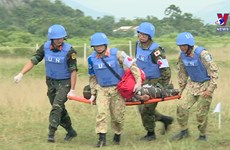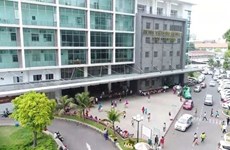Part 2: 'Unbelievable true stories' at grassroots healthcare facilities
 The black-and-white ultrasound machine has been in use for more than 20 years at a general hospital in Thuong Xuan district, Thanh Hoa province (Photo: VNA)Nhập mô tả cho ảnh
The black-and-white ultrasound machine has been in use for more than 20 years at a general hospital in Thuong Xuan district, Thanh Hoa province (Photo: VNA)Nhập mô tả cho ảnhHanoi, (VNA) - At many grassroots health stations, there are so many unbelievable true stories, like a black-and-white ultrasound machine still in use after more than 20 years at a district general hospital.
The old machine is also the only available ultrasound device at the hospital.
Another health station was granted a new ultrasound machine but it has been left unused for several years because no one at the station can operate it.
In major cities, a ward health station has only between five and seven staff members, even when the ward’s population reached 120,000-130,000, which means one medical worker has to manage the health issues of around 20,000 residents.
Still running well
The 20sq.m ultrasound room at the general hospital of Thuong Xuan district, in the central province of Thanh Hoa, is packed with patients every day. The black-and-white ultrasound machine here has worked for more than 20 years, serving over 90,000 residents in the district.
Dr. Le Thi Cam Tu, the ultrasound technician at the hospital, said as the machine is so old, the images are very poor.
 The ultrasound room at the general hospital of Thuong Xuan district (Photo: VNA)
The ultrasound room at the general hospital of Thuong Xuan district (Photo: VNA)According to the hospital’s Deputy Director Dr Cam Ba Thien, the hospital has 240 beds and 170 staff members. Thuong Xuan is a poor mountainous district, and the district hospital lacks medical equipment, meaning it struggles to meet the health care demands of the local people.
Dr Tu said before the pandemic, there were an average of 70 patients needing ultrasound examinations a day. The number dropped to between 40 - 50 a day during the COVID-19 pandemic.
Following the decision to allow COVID-19 patients with mild symptoms to quarantine and self-treat at home, which was meant to reduce pressure on medical establishments, grassroots health stations in mountainous areas faced even bigger difficulties.
Dr Duong Van Quan, deputy director of the health station of Tam Duong district, Lai Chau province, said in mountainous regions, many villages are located in far-flung areas and far from each other, while a communal health station usually has only five workers. They had to undertake an even bigger volume of work during the pandemic.
During April, there were more than 2,000 COVID-19 patients receiving treatment at home in Muong Khuong district of the northern mountainous province of Lao Cai.
Le Thi Nguyet, head of the medical station of Muong Khuong township, said her station had six staff members but five of them tested positive for COVID-19.
The medical station was in charge of managing COVID-19 patients who lived in nine mountainous villages and eight residential areas across the township. Few patients knew how to update their health condition on the COVID-19 app, requiring medical workers to go to their houses regularly to keep track of the situation.
Poor infrastructure and a shortage of equipment and personnel has plagued the grassroots health network for many years. Though the health sector has prioritised grassroots health facilities, especially those in disadvantaged areas, the scope and pace of investment remains modest.
Overloading due to a lack of personnel
According to regulations, a ward/communal-level health station can only have 12 staff members maximum, even though a ward in a big city may have a population of up to 130,000.
Therefore, during the fourth wave of COVID-19, the skyrocketing number of patients in Hanoi and Ho Chi Minh inevitably led to overloads at ward health stations, with medical workers working around the clock but still unable to complete their work.
An example was the health station at ward 22 of Binh Thanh district, HCM City. Two doctors and three nurses at the station had to care for over 500 COVID-19 patients receiving treatment at home. At the same time, they were also responsible for the COVID-19 vaccination drive in the ward.
Joint circular 08/20027 of the Ministry of Home Affairs and the Ministry of Health stipulates that a ward/communal health station has a minimum of five medical workers, serving an average of 8,000 people. For an increase of 2,000-3,000 in population, the number of staff will be increased by one, but not more than 10, which means there would be 10 medical workers for 18,000 people.
Tang Chi Thuong, Director of the Health Department of Ho Chi Minh City, said the populations of wards in the city vary greatly, ranging from 20,000 to even 140,000, but the maximum number of staff members at ward health stations remains limited to 10. This problem has existed for decades.
Hanoi: weaknesses are obvious but there are no easy solutions
Director of Hanoi Health Department Tran Thi Nhi Ha said the ratio of grassroots medical workers is 6 per 10,000 people. The average national ratio is 7.4. The city currently has 579 ward/communal health stations under the management of 30 district-level health centres.
 Director of Hanoi Health Department Tran Thi Nhi Ha (Photo: VNA)
Director of Hanoi Health Department Tran Thi Nhi Ha (Photo: VNA)Some wards in the city have a population of up to 50,000, but their health stations would still be limited to 10 staff members maximum.
Ha added that district-level health centres in the city have only 8,838 staff members, including 1,213 doctors, or 13.7%.
As for the ward's health stations, 66 out of the total 579 stations (or 11%) do not have a doctor.
According to Chairman of the People’s Committee of Hoang Mai district Nguyen Minh Tam, on a peak day, March 3, 1,721 COVID-19 patients lined up to make medical declarations at the health station of Hoang Liet ward, which was staffed by only 11 medical workers. The ward has a population of 90,000.
Despite the heavy workload, the income of grassroots medical workers is low, averaging 5-7 million VND a month (214-300 USD), plus around 2-3 million VND in allowances for pandemic prevention work.
As the pandemic drags on, besides regular duties, grassroots health workers are also tasked with prevention work such as COVID-19 vaccination and monitoring patients quarantined at home.
The medical workers are stretched thin, meaning there are no day-offs or holidays for them. Many had to work even when they were infected with COVID-19 themselves, to prevent disruptions in medical services.
It can be said that the grassroots health system, be that in rural or urban areas, has not received due attention and investment./.
[Grassroots healthcare: standing firm in any situation]













